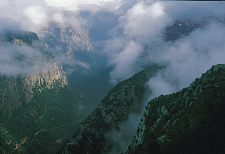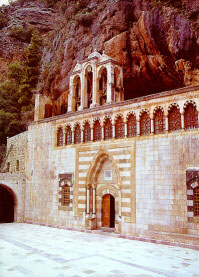Qadisha
Profile Altitude:
1300m
Distance from Beirut: 110km
Getting
There
From Beirut, go north toward Nahr El
Kalb tunnel, and take the highway to Chekka, south
of Tripoli, and then turn up towards Amioun. From there the road passes along
the side of the Kadisha Gorge through Kousba, Tourza, Hadeth El Jebbeh, Qadisha. |

|
General Information
Qadisha, one of the deepest and most beautiful valleys in
Lebanon, is indeed a world a part. At the bottom of this wild steep-sided
gorge runs the Qadisha River whose source is in the Qadisha Grotto at the foot
of the Cedars. And above the famous Cedar grove stands Qornet el Sawda,
Lebanon's highest peak.
The word Qadisha comes from a Semitic root meaning "holy" and Wadi Qadisha is
the "Holy Valley." Filled with caves and rock shelters inhabited from the
third millennium B.C. to the Roman period, the valley is scattered with cave
chapels, hermitages and monasteries cut from rock. Since the Early Middle Ages
generations of monks , hermits, ascetics and anchorites found asylum here.
Even Moslem Soufis were found in this valley.
At the town of Tourza the valley divides into two branches, each named for a
monastery there: Wadi Qannoubin leading to the Cedars. A path goes along the
bottom of the valley through an area called "Bain an-Nahrain" (Between the Two
Rivers) where Wadi Qannoubin meets Wadi Qadisha. From here trails lead to the
various sites.
 |
|
The Qadisha Valley area is surrounded by many important sites and villages
like:
Bqaa Kafra highest village of Lebanon (1750 m), Qornet Es Sawda; the highest
peak in Lebanon (3088 m), Hasroun; one of the last villages in Lebanon to
preserve its traditional red-roofed houses; Qadisha grotto located between
Bsharreh and the Cedars;
Deir Mar Elishaa (Monastery of St. Elieus); Deir Qannoubin built into the
rock, Deir Mar Antonios Qozhaya (Monastery of St. Anthony Qozhaya), Our Lady
of Hawqa's chapel, etc... and the nice village of Ehden.
|
Magharet Qadisha was discovered by the priest John Jacob, a monk of Monastry of
St. Joseph, in 1923. He was looking for the sources of Qadisha river. He
followed the river up to the spring and entered the cave, but he soon ended his
first cave exploration because of the low temperature in the cave. He repeated
his exploration tour soon after with warmer clothes and discovered the cave.
But although he told about his discovery and the inhabitants of
Bsharre knew about the cave, it took until after his death to make another
exploration. Later the cave was well developed and has now easy paths and
electric light.
The cave is the spring of Qadisha river, which means it is a
river cave.
Qadisha cave is beautiful, but small. Unlike Jeita it is rarely
mentioned in guidebooks and so there are very little visitors. But it is not the
only cave in Ouadi Qadisha, there are numerous caves which were used over
centuries for cave churches and monasteries. The cave churches of Mar Sarkis,
Mar Bohana and Mart Shmouna show 13th century paintings. The whole valley with
its cave churches is inscribed in the UNESCO World Heritage List.
Information From the Ministry of
Tourism

|